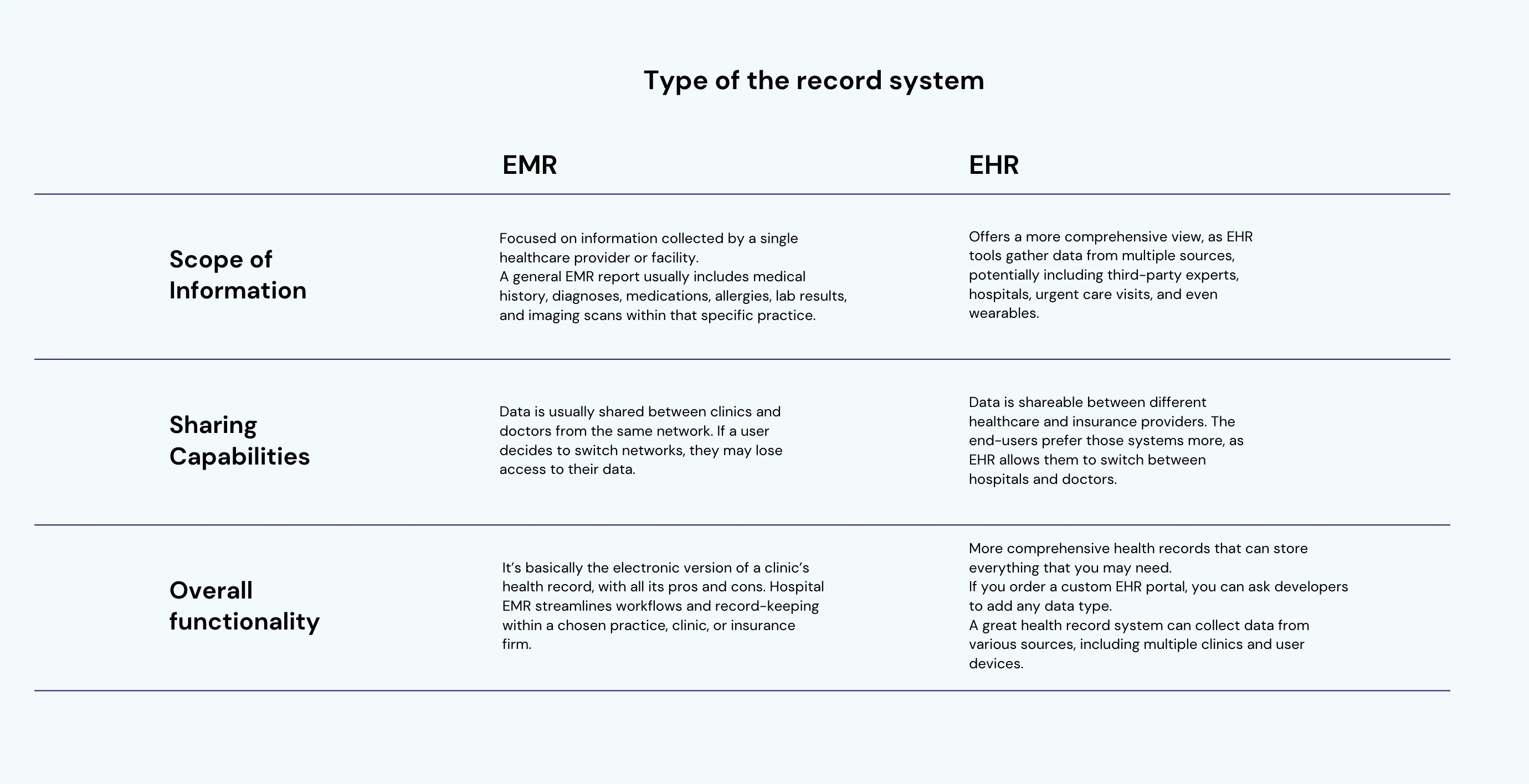
Unsure if your medical office needs EMR and EHR tools? Read this article to determine which medical office software better revolutionizes your healthcare business.
EMR VS EHR: Which Is Better For You?
In today’s data-driven healthcare landscape, data management is necessary for a successful business. EMR and EHR (Electronic Medical Records and Electronic Health Records) are modern cloud-based services that benefit both businesses and their clients (patients).
But what to choose? Which tool suits you more? Check this article to find the winner in the “EMR VS EHR” race in your situation! Explore functionalities, advantages, and their critical role in each system to determine which suits you more.
What is the EMR?
An Electronic Medical Record system is a cloud version of a patient’s medical chart stored within a specific healthcare provider’s office or clinic. Think of it as a secure filing cabinet with an electronical access. You can share it only with other doctors connected to the same system.
An EMR application holds just essential medical information about a patient, such as:
- Medical history
- Diagnoses
- Medications
- Allergies
- Lab results
- Imaging scans etc.
EMR benefits are immediate. Since all information will be available online, they increase hospitals’ medical data management. You don’t need to sort them manually, like with physical documents. You don’t need to scan medical papers, as they are already in the system.
Since EMR stands for the electronic version of the medical record, it reduces the human error factor. If you miss some data or enter something wrong, the system will notify you.
Some of the most well-known EMR examples are CareMD, EPIC, Cerner, and AthenalHealth. These are great solutions, yet their main disadvantages are the absence of a mobile version and the lack of customization for specific clinics’ needs.
EMR data integration also allows patients to view their medical records online. This simple action can empower patients to take a more active role in their healthcare.
What Is The EHR?
EHR tools provide a more comprehensive view of a patient’s health and are designed to be shared securely across different healthcare providers. Here, you can add any medical info you think is right, from doctors’ comments to health data from wearable devices. Just ensure that the chosen EHR system supports it.
The main difference between EHR and EMR is that health record systems are designed to be shareable across different healthcare providers. While electronic medical records are usually tied to a specific clinic network, health record systems are shareable with multiple clinics and insurance companies. It provides more freedom for both businesses and users.
EHR applications allow users to add medical data from wearable devices like smartwatches and glucometers. Patients can journal their health changes, including mood swings and periods. This can provide additional value to doctors who examine patients’ health more deeply.
Sharing data via EHR portals eliminates the need for patients to repeat tests or explain their medical history multiple times. It leads to smoother transitions between different healthcare settings.
Some of the most well-known EHR examples are EPIC, Oracle Cerner, MEDITECH and WellSky. EHR implementation may take more time initially, but it will pay off in the long run. Doctors can diagnose more precisely with this system, which benefits patients’ health. Meanwhile, patients won’t feel tied to specific clinics, so they are more likely to choose to use an EHR service.
Differences Between EMR and EHR
Both types of medical office software aim to store clients’ medical records effectively. However, they have distinctive features. There is no battle between EMR vs EHR, as they are used in different situations. We have gathered their crucial distinctions in the comprehensive table to save you valuable time.

As you can see, both types of medical records have distinctions. To solidify this knowledge, consider EMR an online filing cabinet for a specific clinic, while EHR is a comprehensive patient health story. Most modern EHR support integration with multiple EMR health information systems.
How To Develop EMR And EHR Systems
Developing a custom EMR/EHR system is a complex process that requires expertise in healthcare, software development, data security, and regulatory compliance. Nevertheless, all your efforts will pay off once you try the system that perfectly suits your needs. The general guideline looks similar for any business, whether an EMR for a small practice or an EHR for a huge insurance corporation. Meanwhile, all vital steps remain the same despite your business’s size.
To save you valuable time, we’ve gathered all the crucial steps in this simplified step-by-step instruction:
- Plan the development process. Determine the target audience, research the niche and your main rivals, and figure out their strengths and flaws. Examine the latest international, national, and local data, as well as healthcare and health tech regulations.
- Survey your target audiences, both doctors and patients. Ask them what they need and find out their pain points. Later, you can use this information to determine system functions. It will also help you track their point of view on your app.
- Determine the service’s core functions. From now on, you can start developing an MVP (minimum valuable product). At this stage, you don’t need to create something complex. Just ensure that the chosen medical records programs cover the primary users’ pain points.
- Start developing the app. Design secure data storage and access protocols and ensure interoperability with other healthcare systems for seamless data exchange. Integrate basic features like e-prescribing, order management, and reporting tools. Get EMR certification from your local authorities. Ensure that your app is HIPAA-compliant. It will take a lot of time, but these efforts will pay off.
- Provide the first round of testing (alfa-test) and quality assurance. Don’t even think about releasing the app at this stage. 😉 Address all potential issues to comply with the strictest quality assurance regulations.
- Conduct your first semi-open beta-testing with volunteers. That way, you ensure that you’ll test the service in actual conditions. Address the issues, if any.
- Submit the service to the app store of the chosen platforms. It may take weeks for Apple, Google, and Microsoft to approve the app. You can skip this step if you develop a web-based EMR or EHR.
- Conduct a marketing campaign. Promote your patient record software and explain how your app can improve the lives of your target audience. Show them your system complies with the latest data regulations, so it’s safe to use.
- Conduct the final test before the release. Ensure that your app is user-friendly. Add detailed step-by-step instructions right in the service.
- Make your service publicly available. Don’t forget about ongoing support, maintenance, and promotion. Regular updates and feature enhancements are essential for a successful system.
Wrapping Up
As you can see, EMR and EHR implementation is a lengthy process. Thus, it’s crucial to have the team accountable for it. While collaborating with separate freelancers might be looking sparingly, the reality is quite different. In this case, no one is in charge of the quality of the final products, so you may spend countless hours trying to comply with the results of freelancers’ work to get the eligible EMR and EHR system.
On the other hand, collaborating with teams with vast experience in the health-tech industry is much more efficient. And Corpsoft.io is one such team. We have worked with healthcare and health-tech companies for 6+ years and have dozens of successful projects in our portfolio.
We gladly assist you with the development and provide custom medical records programs on a turnkey basis. We take full responsibility for the development process: from planning the work scope to marketing and after-release maintenance. By choosing Corpsoft.op, you always oversee the development process without the need to micromanage, as we report back each step. It gives you time to focus on more important business aspects.
Contact Corpsoft Solutions today and take the first step towards transforming your healthcare practice with a robust EMR/EHR system.
Subscribe to our blog

